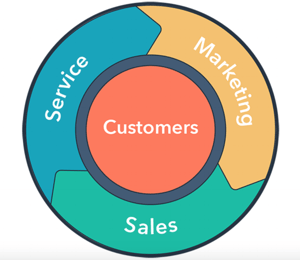You know your activity is driving up revenue — but how can you prove it? In this article, discover how to calculate your inbound marketing ROI and prove the return you're delivering on your marketing spend.
Not two months ago, many business owners will have left the year-end meeting with a problem: they missed their annual target.
Whether or not you were among them, it’s no stretch to imagine the pressure this puts on the commercial team going forward.
An inbound marketing strategy is an effective way of joining the dots between marketing activity and sales revenue. Inbound's approach — of creating a platform of content that reflects popular search terms, matches buyer intent, and addresses their questions — represents a phenomenal opportunity for businesses to drive the dependable, sustainable growth they need to meet — and track — their return on marketing spend.
Unfortunately, this is where many businesses falter. When it comes to turning this tactic into an accountable strategy, they don’t know how to proceed, never mind how to calculate ROMI.

Joining the dots between sales and marketing ROI
Too many companies are still making the mistake of investing in marketing strategies — inbound or otherwise — without taking the time to understand how they can demonstrate their wider impact on the business.
"The cost of a marketing strategy that doesn’t deliver can be crippling."
If you already have a strategy in place and you still missed your target this year, this will ring especially true.
Here’s the thing: your marketing team might argue that it contributed to leads closed, but without the data to back it up, they can’t prove or disprove this either way — and neither can you.
Use this equation and learn how to calculate ROMI
Before we address the deeper problem limiting organisations from demonstrating accurate marketing returns, let’s not forget that on the face of it, calculating ROI is a simple case of balancing cost of customer acquisition (COCA) against the lifetime value of a customer (LTV).
Inbound marketing ROI calculator
- Calculate the cost of customer acquisition (COCA)
- Calculate the lifetime value of a customer (LTV)
- Your marketing ROI is COCA:LTV. Good ROI is essentially a low cost of acquisition and a high lifetime value
If you’re looking at this equation and wondering how you can be expected to calculate ROI when you’re not sure how to work out COCA, you’ve hit the nail on the head.
Unless you can see a lead all the way through from the first marketing touchpoint to the moment they close, you can’t accurately state how much it has cost your organisation to acquire that customer. And without COCA, you have no way of accurately tracking the effectiveness of your sales and marketing machine.
Got a question about your marketing department's ROI? Ask Eric or Chris.
3 ways to start seeing tangible marketing ROI
For businesses looking to align their sales and marketing activities, reduce COCA and see predictable, scalable, and repeatable business growth, it is important to understand three key things.
1. Set smart goals
If you want to double revenue from new business between now and the end of next year, what are the metrics you need to move to make this happen, and how can you create an effective content strategy that will move them?
|
ACTION: Sit down with your heads of sales and marketing and define a series of smart goals and targets that they will agree to meet or exceed.
|
2. Identify the gaps between sales and marketing
Perhaps organic traffic is high but no one is converting. Or leads are going missing between the sales and marketing handover. You might have a strong creative team but struggle to manage the content creation process. The rivalry between sales and marketing may well be responsible for the organisation’s disappointing numbers. Service level agreements (SLAs) counter this, offering an improved insight into what is working — and what isn’t.
|
ACTION: Work with your sales and marketing heads on an SLA that objectively states how they will work together and where accountability sits. It will quickly become clear which elements of a campaign are performing well and which ones could use rethinking.
|
3. Spin the flywheel
 Marketing, sales, and customer service naturally integrate with each other to serve the buyer together.
Marketing, sales, and customer service naturally integrate with each other to serve the buyer together.
Each forms a critical component in what can be creatively imagined as a flywheel, with marketing drawing in and engaging prospects, sales nurturing and closing them, and both departments working together to delight your customers.
Happy customers generally mean repeat purchases, loyal business, and referrals.
|
ACTION: Driving this kind of thinking starts at the top. Educate yourself fully on the flywheel concept, then bring in the C-suite to define what this will look like across your organisation. It will take all of your team to align with one another to achieve the common goal of delighted customers who happily promote you to others.
|
It’s time to go full circle on the marketing ROI problem. Changing your sales and marketing processes to become buyer focused is a transformative step, but it is absolutely crucial if you want to join the data gaps between these two traditionally disparate business units — and walk away from next year’s annual sales meeting smiling.
Now you know how to calculate ROMI, align your sales and marketing operations and prove the return your marketing spend by downloading our 80-page ebook.




 Marketing, sales, and customer service naturally integrate with each other to serve the buyer together.
Marketing, sales, and customer service naturally integrate with each other to serve the buyer together.

.png?width=50)

.png?width=50)
.png?width=50)


































